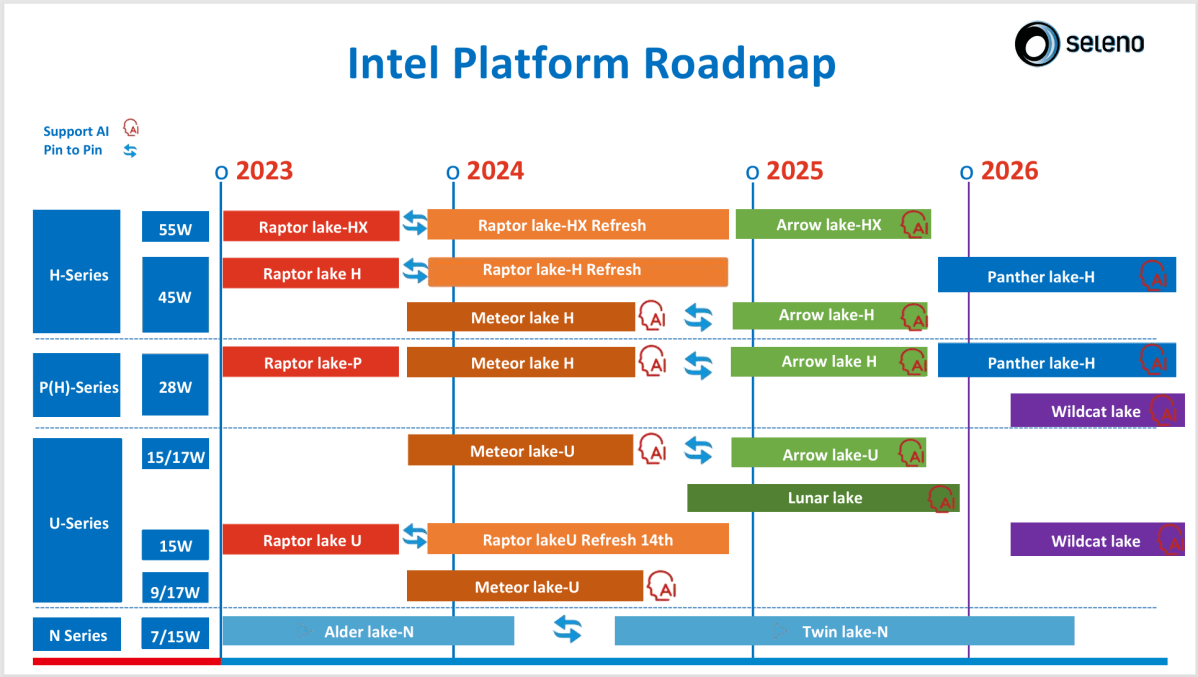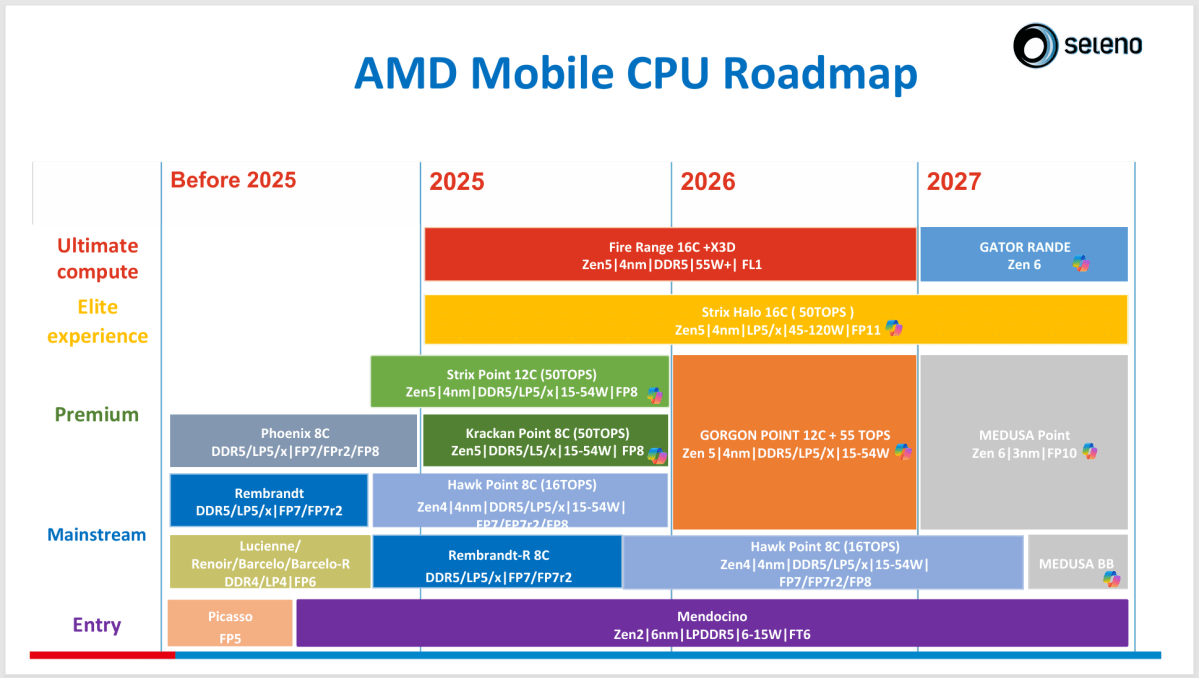- Регистрация
- 17 Февраль 2018
- Сообщения
- 38 911
- Лучшие ответы
- 0
- Реакции
- 0
- Баллы
- 2 093
Offline
Neither AMD nor Intel have confirmed the roadmap, though the Spanish PC maker published it to its web site for customers to view.

Image: Thinkstock
An apparent leak of the planned notebook CPU releases from AMD and Intel have revealed both company’s plans through 2025 and beyond, showing off a complex AMD roadmap that extends in 2027 with the release of “Gator Range” and AMD’s Zen 6 architecture.
The roadmap was published on the website of Seleno, a Spanish electronics manufacturer, and downloadable from a button marked “Roadmap” from the manufacturer’s site. It has not yet been formally confirmed, so it must be considered to be a rumor for now. Tom’s Hardware noticed the post, whose original source appears to be the Twitter account, “X86isdeadandback.”
PCWorld was able to download the roadmap from Seleno itself.
Seleno appears to be a small Spanish electronics company specializing in wireless chargers and power banks. But the company also maintains a notebook business, and published a roadmap of its own products and the roadmaps from AMD and Intel, accessible via the “Roadmap” link. Neither roadmap is sourced to AMD or Intel, and appears to be Seleno’s interpretation of what each company has told them (or simple forecasting rather than an actual leak). The AMD roadmap, however, is far more detailed.
In fact, Intel’s 2025 roadmap, according to Seleno, matches what Intel has already said publicly with one exception: in notebooks, 2025 will be the year of Arrow Lake and Lunar Lake. In 2026, Intel will launch versions of the “Wildcat Lake” processor, a name that Intel has let slip before, in both the mainstream 9-17W “U” segments as well as the higher-performance “P” segment, which carries with it a 28W TDP.

A screenshot of the Intel Platform Roadmap, as published by Seleno.es to its website.
Foundry
AMD’s notebook CPU roadmap is much more interesting. If the roadmap Seleno published is accurate, you’ll have the choice of seven separate CPU choices for 2025, ranging from the aging “Mendocino” Zen 2 parts for entry-level notebooks on up to the 16-core Ryzen X3D or “Fire Range” products, whose desktop counterparts have sparked a sharp increase in AMD’s desktop market share.
An AMD representative declined to comment “on unannounced products, leaks, or speculation.”
AMD’s roadmap shows the Fire Range parts persisting through 2027. AMD’s Strix Halo (the Ryzen AI Max CPU found in the Framework Desktop and others) has no replacement at the current time, the Seleno roadmap indicates, persisting throughout 2025, 2026, and 2027.
The big name on AMD’s alleged roadmap for 2026 is Gorgon Point, which replaces three separate processors AMD ships in 2025: the 12-core “Strix Point” mainstream Ryzen AI 300 Zen 5 series; the “Krackan Point” {sic] 8-core offshoot, which boasts the same Copilot+-class NPU and Zen 5 architecture; and the “Hawk Point” chip, an 8-core Zen 4 processor. The roadmap describes Gorgon Point as a 12-core chip with a 55-TOPS NPU, manufactured on a 4nm process with the Zen 5 architecture.

A screenshot of AMD’s mobile CPU roadmap, as published by Seleno.es to its website.
Foundry
Also in 2026, the Seleno roadmap indicates that AMD is saying that the Hawk Point chip will slip in as a replacement for mainstream notebooks, maintaining its current characteristics as a Zen 4 processor on the 4nm process node, and using DDR5 and LP-DDR5 memory.
Finally, Seleno’s AMD roadmap shows the migration from the Zen 5 architecture to Zen 6 taking place in 2027. Although it’s no secret that AMD is working on future architectures, AMD hasn’t spoken publicly about Zen 6 yet. Its most likely opportunity to do that will be on Nov. 11, when it holds a special day for financial analysts. It’s on those days that AMD typically presents future roadmaps and talks more publicly about its strategies and initiatives.
In 2027, Gator Range will mark the debut of Zen 6 in what Seleno calls the “ultimate compute” category. Mainstream notebooks will follow suit, with “Medusa Point” — a Zen 6 chip on a 3nm process node — taking over from Gorgon Point. AMD also apparently plans what Seleno refers to as “Medusa BB” — possibly a “baby Medusa Point,” as Tom’s Hardware suggests — without any distinguishing characteristics.

Seleno published the roadmaps to its Web site.
Foundry
Interestingly, in 2027 all of AMD’s notebook processors will apparently meet Microsoft’s Copilot+ requirements, with the exception of one: the Mendocino chip, which will keep on puttering along from 2024 until presumably 2027 as beyond.
Seleno’s roadmap contains details of the company’s own notebook plans, as well as which processors the company will include. In a note, Seleno said that it is phasing out Intel’s 12th-gen Core i5-1235U, though the timing will depend on the stock on the open market. Seleno also notes that supplies of Intel’s N-series (Alder Lake-N, Twin Lake-N, and Jasper Lake) remain in short supply.
Updated at 12:13 PM PT with additional detail.
Author: Mark Hachman, Senior Editor, PCWorld

Mark has written for PCWorld for the last decade, with 30 years of experience covering technology. He has authored over 3,500 articles for PCWorld alone, covering PC microprocessors, peripherals, and Microsoft Windows, among other topics. Mark has written for publications including PC Magazine, Byte, eWEEK, Popular Science and Electronic Buyers' News, where he shared a Jesse H. Neal Award for breaking news. He recently handed over a collection of several dozen Thunderbolt docks and USB-C hubs because his office simply has no more room.
Recent stories by Mark Hachman:

Image: Thinkstock
An apparent leak of the planned notebook CPU releases from AMD and Intel have revealed both company’s plans through 2025 and beyond, showing off a complex AMD roadmap that extends in 2027 with the release of “Gator Range” and AMD’s Zen 6 architecture.
The roadmap was published on the website of Seleno, a Spanish electronics manufacturer, and downloadable from a button marked “Roadmap” from the manufacturer’s site. It has not yet been formally confirmed, so it must be considered to be a rumor for now. Tom’s Hardware noticed the post, whose original source appears to be the Twitter account, “X86isdeadandback.”
PCWorld was able to download the roadmap from Seleno itself.
Seleno appears to be a small Spanish electronics company specializing in wireless chargers and power banks. But the company also maintains a notebook business, and published a roadmap of its own products and the roadmaps from AMD and Intel, accessible via the “Roadmap” link. Neither roadmap is sourced to AMD or Intel, and appears to be Seleno’s interpretation of what each company has told them (or simple forecasting rather than an actual leak). The AMD roadmap, however, is far more detailed.
In fact, Intel’s 2025 roadmap, according to Seleno, matches what Intel has already said publicly with one exception: in notebooks, 2025 will be the year of Arrow Lake and Lunar Lake. In 2026, Intel will launch versions of the “Wildcat Lake” processor, a name that Intel has let slip before, in both the mainstream 9-17W “U” segments as well as the higher-performance “P” segment, which carries with it a 28W TDP.

A screenshot of the Intel Platform Roadmap, as published by Seleno.es to its website.
Foundry
AMD’s notebook CPU roadmap is much more interesting. If the roadmap Seleno published is accurate, you’ll have the choice of seven separate CPU choices for 2025, ranging from the aging “Mendocino” Zen 2 parts for entry-level notebooks on up to the 16-core Ryzen X3D or “Fire Range” products, whose desktop counterparts have sparked a sharp increase in AMD’s desktop market share.
An AMD representative declined to comment “on unannounced products, leaks, or speculation.”
AMD’s roadmap shows the Fire Range parts persisting through 2027. AMD’s Strix Halo (the Ryzen AI Max CPU found in the Framework Desktop and others) has no replacement at the current time, the Seleno roadmap indicates, persisting throughout 2025, 2026, and 2027.
The big name on AMD’s alleged roadmap for 2026 is Gorgon Point, which replaces three separate processors AMD ships in 2025: the 12-core “Strix Point” mainstream Ryzen AI 300 Zen 5 series; the “Krackan Point” {sic] 8-core offshoot, which boasts the same Copilot+-class NPU and Zen 5 architecture; and the “Hawk Point” chip, an 8-core Zen 4 processor. The roadmap describes Gorgon Point as a 12-core chip with a 55-TOPS NPU, manufactured on a 4nm process with the Zen 5 architecture.

A screenshot of AMD’s mobile CPU roadmap, as published by Seleno.es to its website.
Foundry
Also in 2026, the Seleno roadmap indicates that AMD is saying that the Hawk Point chip will slip in as a replacement for mainstream notebooks, maintaining its current characteristics as a Zen 4 processor on the 4nm process node, and using DDR5 and LP-DDR5 memory.
Finally, Seleno’s AMD roadmap shows the migration from the Zen 5 architecture to Zen 6 taking place in 2027. Although it’s no secret that AMD is working on future architectures, AMD hasn’t spoken publicly about Zen 6 yet. Its most likely opportunity to do that will be on Nov. 11, when it holds a special day for financial analysts. It’s on those days that AMD typically presents future roadmaps and talks more publicly about its strategies and initiatives.
In 2027, Gator Range will mark the debut of Zen 6 in what Seleno calls the “ultimate compute” category. Mainstream notebooks will follow suit, with “Medusa Point” — a Zen 6 chip on a 3nm process node — taking over from Gorgon Point. AMD also apparently plans what Seleno refers to as “Medusa BB” — possibly a “baby Medusa Point,” as Tom’s Hardware suggests — without any distinguishing characteristics.

Seleno published the roadmaps to its Web site.
Foundry
Interestingly, in 2027 all of AMD’s notebook processors will apparently meet Microsoft’s Copilot+ requirements, with the exception of one: the Mendocino chip, which will keep on puttering along from 2024 until presumably 2027 as beyond.
Seleno’s roadmap contains details of the company’s own notebook plans, as well as which processors the company will include. In a note, Seleno said that it is phasing out Intel’s 12th-gen Core i5-1235U, though the timing will depend on the stock on the open market. Seleno also notes that supplies of Intel’s N-series (Alder Lake-N, Twin Lake-N, and Jasper Lake) remain in short supply.
Updated at 12:13 PM PT with additional detail.
Author: Mark Hachman, Senior Editor, PCWorld

Mark has written for PCWorld for the last decade, with 30 years of experience covering technology. He has authored over 3,500 articles for PCWorld alone, covering PC microprocessors, peripherals, and Microsoft Windows, among other topics. Mark has written for publications including PC Magazine, Byte, eWEEK, Popular Science and Electronic Buyers' News, where he shared a Jesse H. Neal Award for breaking news. He recently handed over a collection of several dozen Thunderbolt docks and USB-C hubs because his office simply has no more room.
Recent stories by Mark Hachman:
